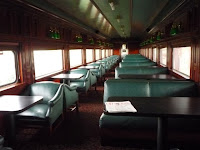We started with a taxi ride to Colón. Our driver, Alfred, took us through the main part of the town to the train station on its fringe. It’s possible to rent a car for very little in Colón. I considered this as an alternative to the more expensive cab/train/cab option. Even with the extra fee to drop the car at Tocumen International Airport, it would have cost far less. In the end, I’m glad we didn’t. Colón is impossibly confusing. The entire city is under heavy construction, there are no road signs at all, and none of the intersections have traffic lights. The procedure at these seems to be: Stop when you arrive to see if there’s a space, then dart into traffic in the direction you want to go, even if you have to cross several lanes of traffic at right angles and they are all headed right at you. Alfred seemed only mildly perturbed by all of the drivers that either cut him off or who refused to let him cut them off, but from the back, it was all quite confusing and hair-raising.
After a very circuitous route that involved many poorly marked construction detours, he finally deposited us at the Colón train station. Taxi fares in Panamá are based on zones, not metered, so we knew Alfred had taken the quickest route for his fixed fare.
We had allowed a generous buffer for canal delays that turned out to be unneeded, so we ended up with quite a lot of time before we could board the train to Panama City. The station is not so much a station as a covered siding. We found a plank of wood alongside one of the sheds nearby and used it as a makeshift bench to sit on while we waited. Our main entertainment for our wait was the busses going by at a nearby intersection. Panamá has a curious bus culture that is proud of its rebellious nature. Most of the public busses are old school busses from the U.S. that have been painted with elaborate airbrush designs and adorned with all sorts of extras like shark fins and big chrome truck exhausts with loud glass pack mufflers. The busses make the city seem even more chaotic.




The Panama Canal Railway - once used for those rushing west for the California Gold Rush
When it finally came time to board the train, we boarded and were immediately stunned with the contrast to the grubby city outside. The train was beautiful. The inside was all polished wood, with green leather seats and those green glass desk lamps. The bulkheads were painted with frescoes of the route. It felt like we had stepped into the Roaring Twenties. We immediately made a beeline for the dome car. The attendant came by with a tray of complimentary coffees and took our drink and snack orders.
The train pulled out of the station and within five minutes, we had left Colón behind and were clacking along the shores of Lake Gatun. We passed still water dotted with tiny islands speckled with herons and cranes. Further along, we spotted the buoys of the canal route, which got closer and closer until we were running alongside the ships on their way between oceans.




We relax as the scenery rushes by
At the Continental Divide, we passed the Miraflores locks, then darted into a tunnel before arriving at Balboa station in Panama City. We had crossed the isthmus in just under an hour.
We took a taxi to a cheap, but clean hotel in town, then headed out looking for a restaurant. We walked a long loop through a lot of dark streets in dodgy areas before we finally ended up at a Venezuelan restaurant across the street from the hotel. The poor waitress that served us as well as the rest of the diners were very understanding and helpful as we struggled to order with our limited Spanish. Eventually, we were brought plates of simple but delicious food that cost us about half what it was worth. We left a chunk of the difference as a good tip for being so patient and cheerful with us. Our waitress seemed confused when we said we didn’t need change. Once she realized it was for her, she accepted it with a blush.
We went back to our room and spent the night trying to sleep through the traffic noise to no avail. When we came down to the lobby at first light, our taxi was already waiting to take us to the airport. We took the south expressway past gleaming skyscrapers separated from the Pacific by a wide belt of parkland bisected by a paved bike path and punctuated with benches in the shade of palm trees.



Arrived in Panama City, Fed, rested, and then off to the airport for an early flight
We parted ways at adjacent gates, where we each got the second to last seats on our respective planes. Now Maryanne is reacquainting herself with British winter while I’m in the milder climate of Arizona enjoying a soft bed and my mother’s delicious cooking.




























